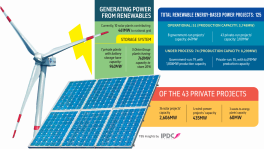COP26: Expectations from the Climate Summit
In the climate summit, we need to have a deep reflection on where we are now, what we have committed ourselves to and what we must do in the future to avoid a climate catastrophe

The time is ripe now for taking rapid actions to combat the greatest challenge of humanity, i.e., climate change, as we have less than a decade to halve the global greenhouse gas (GHG) emission and less than thirty years to realise the goal of net zero-emission. Spearheading measures now also seem to be pragmatic – referable to the momentum induced by the Covid-19 led individual behavioural changes and the plunge in economic activities that have put a temporary dip in global GHG emission.
Likewise, the energy market is more favourable than ever to deploy sustainable energy at an accelerated pace. However, this impetus for sustainable energy promotion and emission reduction can only work if it is supported by effective national policies. Otherwise, the unsustainable resource consumption and wrong policy initiatives for quick economic recovery from the Covid-19 crisis might harm our common goal to address climate change. If history is any guide, we should be concerned as grim pictures were seen in prior examples such as the global energy crises and the Asian financial crisis of the past. In all cases, GHG emission afterwards had rebounded swiftly.
Besides, the clean energy transition process which was agreed upon during the adoption of the Paris Agreement in the 21st Conference of the Parties (COP21) in 2015 is taking longer than expected and hence, the global GHG emission trajectory is not on its way to reaching net zero-emission by the mid-century. The COP26, postponed in 2020, was purported to be the platform for the countries to renew hope with the submission of improved Nationally Determined Contributions (NDCs).
Well, some countries had submitted their revised NDCs by midnight of 31 December 2020 to keep their promises. But the concerning thing is some NDCs are '4° C compatible' meaning these plans fail to meet the target of keeping the global temperature rise below 1.5° C, as was agreed in COP21. In light of these, the COP26 later in November this year in Glasgow, under the leadership of the UK government and supported by the United Nations Framework Convention on Climate Change (UNFCCC) is likely to provide some important directions to the countries that had ratified the Paris Agreement and be a bridge for the yawning gap between the promises of countries and reality.
When the COP26 commences later this year, UNFCCC and the negotiators will be engaged in several key issues. The first and foremost thing at COP26 would be to discuss the level of emission reduction that is realistically attainable with the revised NDCs of the countries. The UNFCCC and UK government would encourage the remaining parties to submit their updated NDCs before COP26.
As the next step, the summit shall share the pathway to be 1.5° C compatible, after taking into consideration the contributions on the basis of the revised NDCs. It would also include discussions on the essential goals for the future NDCs (which are, perhaps, to be submitted by the countries in 2025). Notably, during the groundbreaking Paris Agreement and all the COPs since then, we have mostly found ourselves creating targets and ambitions which are, for the most part, remain unrealized. COP26, therefore, has the historic responsibility to break the cycle and share a clear-cut pathway for mitigating the growing gap between goals and accomplishments which will continue through COP27 and beyond.

While the developed nations agreed to deliver USD 100 billion climate funding per annum to the developing and least developed countries to support climate change projects, the cumulative sum delivered per annum by the developed nations during 2017-18, based on available reports, was way behind their pledge. There are still grey areas in reporting of international climate finance.
Contribution of development cooperation, as Oxfam unveiled, is reported under climate finance and vice versa. The summit shall advance discussions on issues like when the developed countries would ensure the channelling of promised USD 100 billion per annum, both new and additional to their 'development cooperation' contributions. For disbursement of this fund, a good balance between adaptation and mitigation, for which poor countries have been raising voices for years, shall be agreed upon too. It shall, unreservedly, be pronounced that the highly vulnerable and poor countries need the climate funding the most. They shall have easy access to the climate fund, for instance, due to the ramifications that spread over the years after climate change had induced disasters in vulnerable countries.
A recent report by newspapers revealed that some 30,000 people are still homeless after the devastating cyclone Amphan hit the coastal areas of Bangladesh in May 2020. This raises the necessity of taking meaningful decisions to support the vulnerable countries in their pursuit of transformational adaptation.
More clarity on different areas vis-à-vis Article 6 (which allows for a carbon market), one of the complex issues of the Paris Agreement, is also necessary. After what we may call a missed opportunity in COP25, the discourse on Article 6 is still unresolved. The operationalization of Article 6 may help in achieving net-zero emission by 2050 at a lower cost and hence, it should be used sooner rather than later. And the specifics for the market-based instruments are imperative to avoid double counting of emission, i.e., if one country purchases emission reduction from a second country party and reports in its NDC, the emission reduction shall not be reported in the second country's NDC. There, however, lies the potential for enhancing mitigation ambition by both countries – the first country, in addition to mitigation in its own country, might ratchet up mitigation target by supporting more mitigation projects elsewhere and likewise, the second party might undertake more mitigation projects in its own country, supported by other countries, beyond its commitment in NDC.
Article 6 has similarities with the Clean Development Mechanism (CDM) too. Taking all these into consideration, reaching an agreement on Article 6 would require sustained efforts of all the parties and their strong political will. But above all, the forthcoming climate summit must make concrete progress on 'Article 6' instead of procrastinating any further.
In the climate summit, we need to have a deep reflection on where we are now, what we have committed ourselves to and what we must do. It shall not conclude with disappointment rather underpin the ambitious climate actions, both mitigation and adaptation, and be decisive on sustainable global energy transformation. It therefore should lead to competitiveness of renewable energies, temporary fall in demand for energy and the opportunities for building back better and cleaner from Covid-19.
Shafiqul Alam is a Humboldt Schola and an Environmental Economist


 Keep updated, follow The Business Standard's Google news channel
Keep updated, follow The Business Standard's Google news channel















